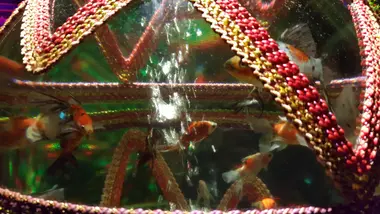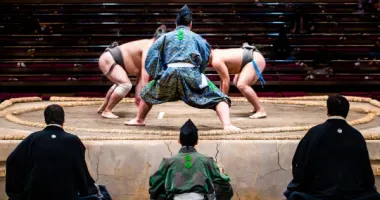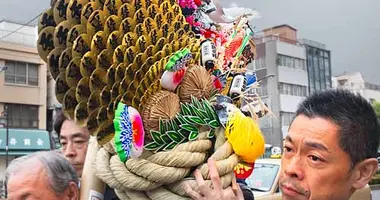Nihonbashi Aquarium Art アートアクアリウム日本橋

Nihonbashi Aquarium Art
Ph.L
The ephemeral aquarium that mixes music and light effects
Every year, the Nihonbashi district hosts the "Art Aquarium- Edo Coolness of Ningyou" exhibition, a sound and light show that highlights the Edo period (1603-1868) through beautiful aquariums. An unmissable Tokyo summer event for 11 years now, which we take pleasure in discovering (and rediscovering) both day and night.
Goldfish headlining
Fascinated by marine fauna from a very young age, the Japanese artist Hidetomo Kimura imagined in 2007 a project that would highlight Japanese culture while sublimating the beauty of the little beings that fascinate him.
This is how " Art Aquarium- Edo Coolness of Ningyou" is born, an exhibition on the Edo period which revolves around one of the most emblematic fish of this period of Japanese history: the goldfish!
Very popular on the archipelago, the goldfish was the subject of a real fashion at the beginning of the Edo period (1603-1868).
Then used to decorate the gardens of the nobility, the little fish gradually became the symbol of Japanese summer. And from the prints featuring the summer season, to the combs and kimonos that the geisha tear off, we are starting to find it everywhere!
Even today, goldfish remain associated in Japan with the heat of summer. A symbol dear to Kimura, which the artist has brought to life every year in the capital through his exhibition for 11 years now.

Aquariums are a way to pay homage to the Edo period
Ph.L
A sound and light show that puts Japanese culture in the spotlight...
It is in complete darkness that visitors are invited to discover this exhibition, which is lit only by the aquariums it depicts.
Indeed, ArtAquarium Niho n bashi revolves around a dozen glass structures in which several varieties of Japanese goldfish swim. A layout that looks like a magnificent sound and light show, halfway between entertainment and a history lesson.
See also: Digital Art Museum TeamLab
And for good reason, all the aquariums refer directly to the Edo period!
From the huge stage at the top of the central esplanade representing the skirt of a courtesan surrounded by these musicians , to the ceramic vases supposed to recall the jewels of the nobility , all the makeshift goldfish enclosures are meticulously studied so that visitors have the impression to walk the streets of Edo , metaphorically of course!

The courtesan accompanied by her musicians
Ph.L
A journey through time, which is however tinged with modern technology, since all the aquariums change colors to the rhythm of the music which mixes traditional melodies and electro sounds. A nice contrast which is therefore in the image of the exhibition: bringing the past to life while marveling at what the present has to offer us.
To read: The 5 most beautiful aquariums in Japan
… day and night
Particularly captivating during the day, ArtAquarium Niho n bashi becomes truly magical when the sun goes down.
Indeed, the exhibition hosts several nocturnal events every week to liven up its aquariums. Kabuki theatre , geisha shows , or even DJ evenings , visitors can enjoy the finest Japanese arts have to offer in a cozy atmosphere , unique to the exhibition.

A stage is present at the end of the exhibition to host night events
Ph.L
Address, timetable & access
Address
Timetable
in front of Mitsukoshimae Station (subway Ginza, Hanzomon lines)Price
adult 1,000 yen (7.73 euros), child 600 yen (4.63 euros), supplement for night events (see prices on the official website of the exhibition)Access
July 6 to September 24, 10:30 a.m. to 8 p.m., evening events from 9:30 p.m. to 11:30 p.m. (see the evening schedule on the official exhibition website)Website
http://artaquarium.jp/en/




























